One of my New Years Resolutions was to drink a lot more Madeira this year. So in addition to organizing a FTLOP Fortification Tour visit to Madeira next month (mid-May), I decided to create a troika of Madeira tasting dinners in different cities across the USA.
The plan was to do a few (3) during the first quarter of the year and at least one or two towards the end of this year as well.
It was Sunday afternoon, January 7th and a group of 15 Madeira lovers descended on Kaspar’s Special Events & Catering (http://www.kaspars.com) which provided us with a private room and a most enjoyable dinner. The lineup was impressive, with bottles representing 7 distinct Madeira grapes/styles:
- Sercial
- Verdelho
- Bastardo
- Boal
- Terrantez
- Malvasia
- Moscatel
Of the 17 bottles of Madeira, 11 were from the 19th century. These bottles totaled 2,264 years of bottle age, which is slightly more than 133 years old for the average bottle, all of which ranged between 80 and 180 years old! I can’t think of a better way to kick off the “Madeira Road Show” than having this combination of diversity of grapes, producers and bottle age.
I’d like to thank each of the following participants for bringing such great bottles and making this event one that I will always remember:
- Peter Reutter - Germany
- Hans Reutter – Bellevue, WA
- Don Thomas – Silver Springs, MD
- Chuck Miller – Seattle, WA
- Richard Beeken – Edmonton, Canada
- Eric LeVine – Seattle, WA
- Richard Jennings – Silicon Valley, CA
- Ed Murray – Sammamish, WA
- Joan Murray - Sammamish, WA
- Justin Wells – Olympia, WA
- Mark Madsen – Seattle, WA
- Stewart – Seattle, WA
- Mark Olsen – Seattle, WA
- Kris Henderson – Seattle, WA
- Roy Hersh – Sammamish, WA
Here are the tasting notes on the Madeiras. There are no drinking windows included, as the vast majority of wine evaluated below, will most likely outlive anyone alive on the planet today. The first flight was made up of the drier styles of Madeira - Sercial & Verdelho:
1862 D'Oliveiras Sercial Vintage Madeira – D’Oliveiras was founded in 1820 and the company has remained in the family’s possession ever since. Their cellar dates back to 1619 and they own lots of key vineyard sites around Sao Martinho on the South coast of the island. Just about all of the D’Oliveiras bottlings come from their own wines, not juice purchased from other producers or special lots that were sold off. The family believes that cask aging is far better for Madeira than aging in bottle; therefore they only bottle what is needed to meet current market demands. The 1862 has a Maple color with a yellow edge and it shows a cloudy appearance. Expansive nose of dried peach, mahogany, orange and lime zest leap from the glass, with a degree of VA which I find so appealing in Madeira. I immediately sensed the intensity of the acidity which provided all the backbone this Sercial needed to remain focused, while the light body weight and seamless texture provided a degree of elegance. The potent combo of toffee and dry walnut flavors were generous as was the lingering aftertaste which was a bit salty and with a final layer of distinctively dry, burnt chestnut. A very fine Sercial and what a beginning to the Seattle tasting! 94+ points (1/7/07)
1898 Barbeito Sercial Vintage Madeira – The second of a pair of Sercials at the Great Seattle Madeira tasting, the ’98 exhibited a dark amber color with yellowish meniscus. It spent at least 80 years in wood before transfer to demijon, of which there are 7 left in existence, this Barbeito was bottled in late 2002. The polar opposite in terms of aromatics from the previous bottle (1862 D’Oliveiras Sercial) with a musty note that morphed to bouillon cube dominating the profile, along with chocolate, lime and spice. This Barbeito provides greater viscosity and is medium-bodied with a delicately smooth mouth feel. In comparison to the 1862 which I preferred, to its credit this leaned more to an off-dry style and a superior texture, but it is not as focused due to its lack of mouth watering acidity. Lavish hazelnut and undertones of dried apricot come to the fore and the Sercial drying aftertaste reminds me of a fine Fino Sherry. 91 points (1/7/07)
1885 Barbeito Verdelho Vintage Madeira – Coming on the heels of the decadent 1850, it had big shoes to follow in, yet this 1885 bottling rarely excites me but it is fun to try nonetheless. The color still shows a very light ruby in the center, surrounded mostly by tawny and a rim that has a greenish tinge. Earthy and fragrant bouillon cube, spicy cinnamon red hots and espresso beans round out a unique nose that shows a light dose of VA, actually less than I would have liked. Leaning towards Sercial in its dry styled performance, this Barbeito is more about finesse than overwhelming flavors or complexity. It is not a style that I prefer in Verdelho, which has become one of my two favorite Madeira grapes (along with Terrantez). I don’t have to have the “big and brash” either, but a happy medium does it best for me. Tangy orange liqueur with almond paste flavors are genteel but simple and deliver a slightly shorter finish than any other Madeira to this point in the tasting. 88 points (1/7/07)
1900 D'Oliveiras Verdelho Vintage Madeira – A nice change up from a great vintage for Madeira. Dark orangish-brown color with a broad yellow band and green outer edge. The swirling ethereal scents of caramelized brown sugar and torched crème brulée with spicy, candied nuts and pungent VA are tantalizing and ever changing. Medium-bodied with a solid core of acidity but I had the sense this could have used more time in the decanter as I have had better showings in the past. Regardless, it was an attractive Madeira with a balance of acidity and soft richness in the mouth that I love in the finer examples of the Verdelho grape. The concentration and layers of complexity are the strong suit, while the clipped finish was a bit of a letdown. 93 points (1/7/07)
1912 D'Oliveiras Verdelho Vintage Madeira – Although this was one of the bottles I presented, the rest of this specific lot will stay put in my cellar for another five years to break out on the 100th anniversary of the tragedy that was the sinking of the Titanic. That was why I initially bought this particular wine. I’ve also had it several times during tasting events and also after dinner at restaurants. Mahogany in color with yellow-tawny glints. Orange blossom, lemon custard and salty ocean mist define the full arsenal of aromatics here. The acidity was bright and complemented the off-dry flavors of bittersweet chocolate, toffee, coffee and hazelnuts. It was lighter in body than I remember and delivered a tart, lackluster finish with a slightly bitter aftertaste. The nose was the best part of this wine and from the 3 or 4 other bottles I have tasted, this one did not live up to its typical performance. 92 points (1/7/07)
The second flight was comprised of an example of Bastardo and a quartet of Boal bottlings:
1927 D'Oliveiras Bastardo Vintage Madeira – This rare grape came to Madeira by way of Greece in the 15th century. Phylloxera killed off this grape in Madeira in the final quarter of the 19th century and very little has ever been produced. This is the only example of a Bastardo producing vintage from the first half of the 20th century (that I am aware of). Mannie Berk, founder of the Rare Wine Co., says that 1927 was the last vintage of four Bastardo vintages, that was EVER produced. The others were 1870, 1875 and 1876. This bottling is from Adegas de Torreao and very little was ever bottled due to extremely low yields and the amount vinified was simply too small to bottle on its own. When the inventory of Torreao was sold to D’Oliveiras in 2002, this was one of the gems in their cellar. It was bottled in 2006 from an original cask. Henriques & Henriques also own a few barrels of their own 1927 Bastardo (and possibly Leacock’s too). Sadly, I don’t think there is any Bastardo grapes grown on the island today, as this grape is considered “extinct” there. Ironically Bastardo is easily found throughout the Douro’s Port wine region. The color was interesting as there was still a touch of light ruby visible in the center of the maple hued Madeira. A fresh and zesty ménage à trois of pink grapefruit, orange marmalade and walnuts were sublime and kept my nose in the glass. Sadly, the palate did not deliver the same level of pleasure. There was a fairly light weight to the wine and an uber-dry style unlike any other Bastardo I’ve experienced; with exacting acidity … the overall profile did not match the grape expectations. It finished with modest length and a nice aftertaste of saline and hazelnuts. 91 points (1/7/07)
1827 Quinto do Serrado Boal Vintage Madeira – Moving back in time from the 1927 Bastardo to a Madeira exactly one century older, was not the only thing that enabled this beauty to stand out as the best wine of the flight and my runner up for WOTN. This 1827 bottling has nearly doubled in price since Nov. 2002 as it continues to grow ever more scarce. Today only bananas grow where the grapes of Serrado were once cultivated in Câmara de Lobos. The wine itself aged for 108 years in wood before being moved to demijons where it continued to mature for another 53 years until it was finally bottled. It shows a dark amber color with a tawny meniscus. Initially there was some bottle stink, but fortunately that blew off rather quickly. Rarely have I found both vanilla and chocolate present simultaneously in a wine, but here they are together along with black currants and maple fragrances. The intense and mouth watering attack of bracing acidity envelops the mouth and provides the supple spine of this wine. A viscous concentration of crème caramel and liquid butterscotch are inspired by chocolate covered raisins and vanilla extract flavors, creating a complex and sexy glass of Madeira. Not to be lost in the glory of the taste of this wine is the textural pleasure, which is incredibly rich, velvety and dripping with glycerin. The opulent aftertaste can be measured in minutes, framed by a chocolate nuance that is surreal. Jeez this is fine juice and a simply stunning 180 year old example of Boal! 97+ points (1/7/07)
1863 Barbeito Bual Vintage Madeira – Following the 1827 Q do Serrado Bual is no easy feat but in comparison, this was not even on the same planet. In fact, many of us felt that this was the weakest Bual in the flight. My notes on the aromatics are scary with descriptors of sauerkraut, rubber and vegetal scents sounding most unpleasant. Fortunately, and I do mean that … the flavor profile was considerably more to my liking. Although medium-bodied and a bit angular, there was a pleasing toasted almond highlight along with vanilla and a slightly herbal taste. The finish was a bit clipped, with a sense of sea salt and a tasty dark chocolate aftertaste. This was the weakest link and hopefully, other bottles of this Barbeito are better off. 84 points (1/7/07)
1903 D'Oliveiras Bual Vintage Madeira – Medium coffee color with a yellow edge led to a captivating bouquet of beef bouillon, sweet glove leather, mocha, sea mist and the perfect dose of VA which for me enhances a fine Madeira to a point. Pinpoint focused acidity is the counterbalance for the young and intense 1903’s powerful palate presence with flavors of stewed prunes, dried figs and salted cashews. The saltiness added to the intricacy while the brash cocoa aftertaste continued on long after swallowing. Another excellent D’Oliveiras bottling that is seamless and a pleasure to roll around in the mouth. 96++ points (1/7/07)
1907 Blandy’s Bual Vintage Madeira – I probably like this more than the majority of other participants in the Great Seattle Madeira Tasting, The afternoon of the previous day before the tasting, I opened six bottles of Madeira to decant them for this event. Initially upon pouring all of them, I made sure to get a great whiff of each as they were being poured. The aromatics on this wine were so pure and powerful, I doubt I’ll ever forget this particular bottle. It was like the essence of espresso beans and so intense that within two hours my entire downstairs living room took on this sweet smell, made more incredible as I almost never drink coffee. I could not wait to try this Blandy’s the following day. Dark brown milk chocolate color. It is infused with enticing accents of maple syrup, roasted coffee bean, burnt sugar and loads of ethereal VA, which create a complex and heady scent. Wow, I loved the perfume of this wine which a day later is no longer just a one trick pony. Thick and rich with a generous and unctuous approach. This was so easy to drink that it is probably a good thing it is not easy to come by. Blandy’s delivers here, accessorized by a tangy balsamic reductive flavor, dark cocoa, roasted chestnuts and a yummy rich Frappuccino aftertaste. 95+ points (1/7/07)
The third and final Madeira flight leads off with an ultra-rare and exotic Terrantez, followed by a foursome of Malmsey/Malvasia and a wonderful Moscatel to wrap things up before starting dinner:
1846 Blandy’s Terrantez Vintage Madeira – Finally! I was waiting for my friend Eric to mention, “cooked onion” as for some reason I’ve never been able to get that smell from a Madeira but others agree with Eric that it is a common and descriptive note in many bottlings. He got a solid dose of it here and as much as I tried to imagine it, it just never sunk in for me. Anyway, this Terrantez is one I never knew existed except from an email discussion with Peter and he brought this along to amaze us. The 1846 presents a dark cola color with an amber/orange edge and is quite cloudy, probably due to the transport of the bottle a few weeks earlier, after years in Peter’s cellar. Someone mentioned French onion soup so I’ll add it in here, but I sensed ripe figs, smoky caramel, chocolate and overripe Seckel pears on the bouquet with a lifted note of VA to bring it full circle. The panoply of fragrances in this wine was going to stay with me long after this tasting. It is hard to believe that it was bested by the palate though, which delivered a concentrated combination of jaw dropping acidity, silken textural appeal and an impeccable flavor profile. Kind of like a three ring circus in my mouth and in this case the seamlessly integrated butterscotch pudding, candied pralines and dried apricot nuances won me over immediately. So vibrant and creamy on the everlasting finish with elegance rarely achieved at this level. It took a conscious effort just to swallow after sniffing and rolling this elixir around in my mouth. It is probably the 2nd best Madeira I’ve ever tasted and only the hedonistic 1802 Acciaioly Terrantez bests this experience and not by much. I can certainly understand why Peter considers this his personal favorite Madeira which he re-corked in 2003. This Blandy’s and the 1802 would make for the ultimate Terrantez taste off; or better stated -- Madeira taste off. 98+ points (1/7/07)
1830 Quinta do Serrado Malmsey Vintage Madeira – Not as great as the bottle I had in Oct. 2004, but a solid showing nonetheless. Maple syrup color with a yellow rim. The nose was quite reticent for over an hour after it was poured and it finally unwound to provide finely interspersed scents of a salty ocean breeze, along with lime zest, dates, vanilla and toffee. Smooth, sweet and quite concentrated, the mouth feel is silky and polished while delivering a medium body. The 1830 is a lithe beauty with palate cleansing acidity and copious quantities of caramel and crème brulee that lead to a lingering and layered finish. 95 points (1/7/07)
1834 Barbeito Malvasia Vintage Madeira – Dark coffee color with yellowish green tinged rim. Let me start by saying that I have had this either 15 or 16 times now, far more than any other vintage Madeira. Before going any further I can say unequivocally that this bottle was flawed and not showing anywhere near its typical self. It was not TCA and it wasn’t cooked (not that the latter would matter too much) but clearly there was some defect. That said, it was certainly still drinkable and not terrible. The nose presented some bouillon, meaty and smoky notes (slight Brettanomyces) with a ton of VA. However, there was also a shrill artificial plastic scent that was powerful and took away from the pleasant aromatic facets. A nice attack of acidity upon entry, maybe a bit too much, which is something in Madeira I don’t know that I’ve ever noted before. The richness came through on the palate and besides tasting the Brett, there were flavors of bitter nut shell, mocha and herbs. It is a darn shame that those who had never had this bottling, did not get a chance to see its true beauty. n/r (1/7/07)
1836 Oscar Acciaioly Malmsey Vintage Madeira – Most of the group liked this far more than I did. I can’t say it was flawed, but given the old Acciaioly bottlings I have experienced, this was the least exciting I have tried. Dark amber in color with a tawny rim. Red fruit fragrances of raspberry and cherry, as well as walnuts and toffee, with a soapy/chemical quality that was mildly off-putting. This was a weird showing and I was so looking forward to this 1836. Smooth on the palate and quite viscous with butterscotch and a tangerine element that seemed odd here. Regardless, overall it was still tasty but was quite atypical for Malmsey. 89 points (1/7/07)
1875 D'Oliveiras Moscatel Vintage Madeira – Dark chocolate color with a tawny rim. Here again, I was going against the tide as quite a few folks did not like this bottle. It may not have shown the pure innate qualities of Moscatel that I love, but I rather enjoyed this ’75. The nose demonstrated ample accents of smoky, dark chocolate, cocoa powder and plenty of VA. The palate was even better with an abundance of vibrant acidity, dried figs and apricots that came to the fore and a prune note on the medium length finish. 92 points (1/7/07)
EPILOGUE: The first two flights provided some peaks and valleys but were pretty consistently “on” and as tasty as they were educational. The last flight was mired in Madeira malaise although the Terrantez was a truly exceptional bottle. Although five hours had passed by while we drank and discussed each and every wine, hunger had set in and it was now time for a great six course dinner and plenty of wines to accompany each course.
Kaspar’s Madeira Mania Menu:
Curley Endive with Grilled Manchego Grape Leave Bundles & Truffle Oil Vinaigrette
Winter Root Vegetable Barley & King Crab Chowder
Marlin on Sun-dried Tomato Beluga Lentil Ragoût
Grilled Boneless Quail in Crispy Potato Crust with Madeira Butter
Braised Beef Short Ribs with Celery Root & Fingerling Potato Hash
Warm, Decadent Chocolate Brownie with a Hot Mocha Sundae
I was finished writing tasting notes, so I just jotted down some of the wines we tried and they’re listed in vintage order, not in the order of how they were served. I believe I missed about four or five that I did not try:
- 1985 Chave Blanc
- 1989 Jaboulet Les Jumelles Cote Rotie
- 1990 Gruaud Larose
- 1990 Montrose
- 1993 Forman Cab
- 1994 Phelps Backus Cab
- 1995 Les Cailloux
- 1995 Pegau “Cuvee Laurence”
- 1996 Hill of Grace Shiraz
- 2003 Vice Versa Cab
- 2004 Kistler “Kistler Vineyard” Pinot Noir
- 1996 Weingut Reichsrat Riesling Eiswein

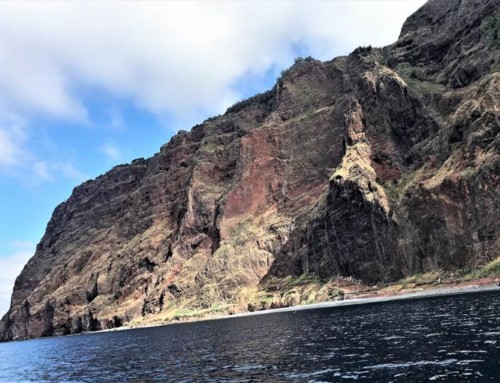
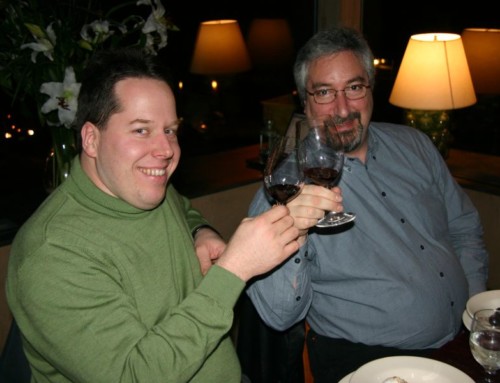
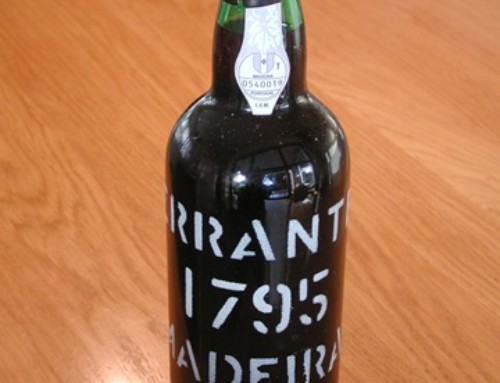
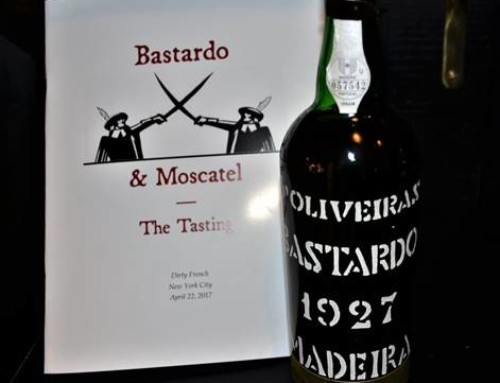
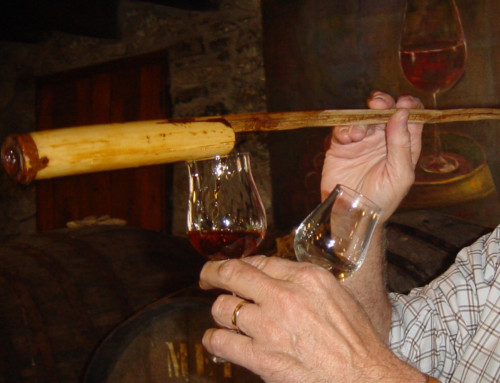
Leave A Comment
You must be logged in to post a comment.